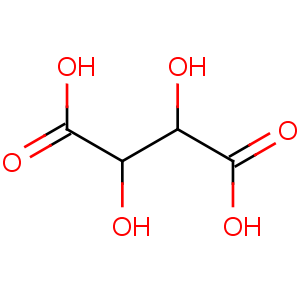Title: L-Tartaric Acid
CAS Registry Number: 87-69-4
CAS Name: (2
R,3
R)-2,3-Dihydroxybutanedioic acid
Synonyms: ordinary tartaric acid; natural tartaric acid;
d-tartaric acid; (+)-tartaric acid; dextrotartaric acid; L-2,3-dihydroxybutanedioic acid;
d-a,b-dihydroxysuccinic acid; Weins?ure (German); Weinsteins?ure (German)
Molecular Formula: C4H6O6
Molecular Weight: 150.09
Percent Composition: C 32.01%, H 4.03%, O 63.96%
Literature References: Dextrorotatory tartaric acid having a levo configuration. Widely distributed in nature, classified as a fruit acid. Occurs in many fruits, free and combined with potassium, calcium or magnesium. Observed in antiquity as the acid potassium salt found deposited as a fine crystalline crust during fermentation of grape juice or tamarind juice and termed
faecula (little yeast) by the Romans. The derivation from
Tartarus is of medieval, alchemical origin. In modern processes the acid potassium tartrate obtained during wine-making is first converted to calcium tartrate which is then hydrolyzed to tartaric acid and calcium sulfate: Metzner,
Chem. Eng. Prog. 43, 160 (1947); several modifications, e.g.,
IT 490221 (1954 to Procedimenti Chimici),
C.A. 50, 11607c (1956). Extraction from tamarind pulp in about 10% yield:
IN 52167 (1955),
C.A. 50, 5249g (1956). Synthesis by hydroxylation of maleic acid: Church, Blumberg,
Ind. Eng. Chem. 43, 1780 (1951). Practically all of the L-tartaric acid sold today is a byproduct of the wine industry. Monograph: U. Roux,
La Grande Industrie des Acides Organiques (Dounod, Paris, 1939). Example of a modern process: Dabul,
US 3114770 (1963 to Orandi & Massera).
Properties: Monoclinic sphenoidal prisms, mp 168-170°. Stable to air and light. Strong acid taste. Refreshing when in dil aq soln. d420 1.7598. Odor of burnt sugar when heated to mp. [a]D20 +12.0° (c = 20 in H2O). Strong organic acid. At 25° pKa1 2.98; pKa2 4.34. pH of 0.1
N soln: 2.2. Heat of combustion: -275.1 kcal/mol. Specific heat: 0.288 cal/g/°C at 21 to 51°; 0.296 at 0 to 99.6°. Dielectric constant 36.0 for 1200 cm waves. Freely sol in water. d415 of aq solns (w/w at 15°): 1% 1.0045; 10% 1.0469; 20% 1.0969; 30% 1.1505; 40% 1.2078; 50% 1.2696. Max soly in water in g/100 ml at various temps: 0° = 115; 10° = 126; 20° = 139; 30° = 156; 40° = 176; 50° = 195; 60° = 217; 70° = 244; 80° = 273; 90° = 307; 100° = 343. One gram dissolves in 0.75 ml water at room temp, in 0.5 ml boiling water, 1.7 ml methanol, 3 ml ethanol, 10.5 ml propanol, 250 ml ether. Also sol in glycerol. Insol in chloroform.
Melting point: mp 168-170°
pKa: pKa1 2.98; pKa2 4.34
Optical Rotation: [a]D20 +12.0° (c = 20 in H2O)
Density: d420 1.7598; d415 of aq solns (w/w at 15°): 1% 1.0045; 10% 1.0469; 20% 1.0969; 30% 1.1505; 40% 1.2078; 50% 1.2696
CAUTION: Can cause local irritation.
See Patty's Industrial Hygiene and Toxicology vol. 2C, G. D. Clayton, F. E. Clayton, Eds. (Wiley-Interscience, New York, 3rd ed., 1982) p 4937, 4943-4945.
Use: In the soft drink industry, confectionery products, bakery products, gelatin desserts, as an acidulant. In photography, tanning, ceramics, manuf tartrates. The common commercial esters are the diethyl and dibutyl derivs used for lacquers and in textile printing. Pharmaceutic aid (buffering agent).

